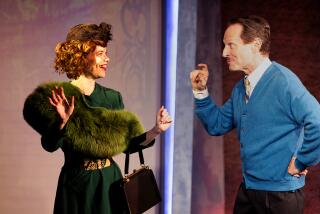AROUND HOME : Rosenschale Bowl
- Share via
The Hapsburg Empire went down in World War I in a blaze of glory: Mahler and Strauss still dominate the late-romantic symphonic repertoire, Freud looms large in psychiatry, and Josef Hoffmann epitomizes fin de siecle design.
In 1897, the Moravian-born architect, then 27 years old, helped found the Wiener Sezession to provide an alternative for designers and artists disenchanted with the moribund, state-run Kunstlerhaus. Sezession philosophy ran counter to the (still) prevalent notion that the decorative arts were inferior to “fine” arts such as painting and sculpture.
As the first issue of the house organ, Ver Sacrum, put it: “We recognize no distinction between ‘high art’ and ‘minor art’; between art for the rich and art for the poor. Art is everyone’s property.” Never mind that things didn’t quite work out that way: The Sezession members’ rejection of machine production ensured that their products would be too costly for the working class.
Six years later, inspired by a trip to C. R. Ashbee’s London Guild of Handicraft, a large workshop producing beautifully crafted art objects, Hoffmann and artist Kolomon Moser established the Wiener Werkstatte.
By 1905, Wiener Werkstatte was the center of progressive design in Vienna, boasting more than 100 workers making metalwork, jewelry, leather work and furniture, mostly to Hoffmann’s designs. But the Wiener Werkstatte went bankrupt in 1932 and was sneered at during the modernist, anti-ornament ‘50s and ‘60s.
In fashion, what goes around comes around, and today the Wiener Werkstatte’s stock stands higher than ever (as the Museum of Modern Art’s blockbuster “Vienna 1900” show of 1986 proved). Indeed, were Hoffmann alive, he would be a rich man from royalties on the dozens of revivals of his designs. They all have interesting stories. But none rival that of the Rosenschale Bowl.
Hoffmann’s long-lost bowl was “resurrected” recently for production by Italian manufacturer Alessi by Arnell/Bickford Associates, the trendy Manhattan advertising agency known mostly for offbeat “soft-sell” advertising campaigns.
The Hoffmann project began when Peter Arnell chanced on a photograph of the 1906 bowl. “Only the prototype existed, and it never entered production; not even a drawing or sketch remained,” he says. But the prototype sufficed for computer whiz David Teters and his Harris 500 computer to make production sketches.
“We believe it’s the first critical reconstruction of a historical object,” says Arnell, who dubbed the piece in honor of its repeating rose motif, also the Wiener Werkstatte’s logo. The electroplated brass bowl (about $200) blends art and technology in the best Wiener Werkstatte tradition. Hoffmann, one feels, would have approved of the posthumous partnership.
The Rosenschale Bowl is available at all Neiman Marcus stores, and at Lynne Deutch Limited in Los Angeles.
More to Read
The biggest entertainment stories
Get our big stories about Hollywood, film, television, music, arts, culture and more right in your inbox as soon as they publish.
You may occasionally receive promotional content from the Los Angeles Times.










